In our How to Paint Everything series, we take a look at different armies of the Warhammer universe, examine their history and heraldry, and look at several different methods for painting them. In this chapter, we’re focusing on that “history and heraldry” bit, looking at some heraldry basics such as what colors to choose, and what devices and patterns can mean on our models.
Heralding Our Arrival: What is This Whole Heraldry Thing?
Heraldry is the use of colors, patterns, and symbols to denote personalities and allegiances on the battlefield. In the chaos of battle, being able to identify your allies was as important in ancient warfare as it is now. The real world history of heraldry dates back thousands of years, with early examples being found on ancient Egyptian shields and standards. At various points in Greek history, their warriors carried large round shields known as an aspis or hoplon, which commonly had designs painted on them that would be identifiable today as heraldry. The Iliad had a whole damn chapter about Achilles’ shield for Zeus’s sake. The (extremely long) description of said shield makes a point that this shield isn’t just a tool of war, but a masterwork of art. The use of heraldry continued into the Middle Ages through to the modern day, which is where we’ll start to see patterns that feel at home with Warhammer’s gothic aesthetic.
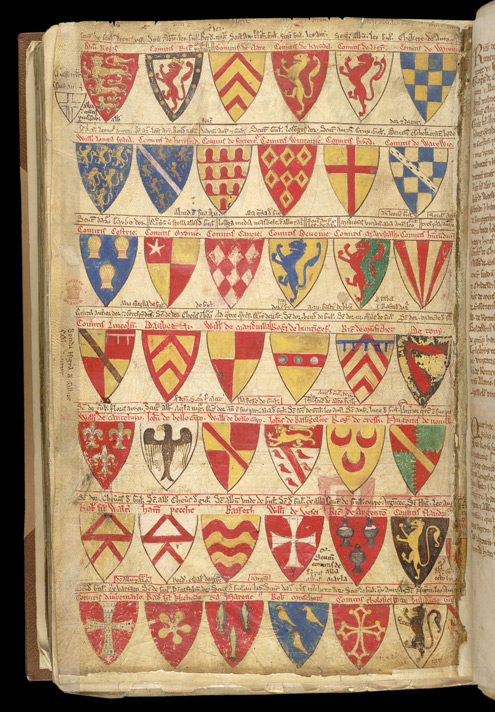
The usage of animals, patterns, and colors each tell a story about the people bearing the shield. Said shields would often be integrated into a coat of arms or family crest, which involved banners, helmets, wreaths, badges, animals, and other design elements. You wouldn’t usually see a full coat of arms portrayed on a shield, but these complex designs could be found on banners or tapestries belonging to nobles and knights.
Heraldry wasn’t just prevalent in Europe, however. Identifying the troops and property of households and clans was just as common in the rest of the world. The patterns on cowhide Nguni shields served as heraldry for the African tribes using them, with specific varieties of cattle being bred just for their distinctive hides. Japanese Daimyos each had their own heraldry as well, which much more closely resembled that of the European nobility albeit with a different aesthetic. From China to Chile, armies marched under banners displaying the colors and patterns of their lords and lands.
While heraldry continued to evolve, shields bearing loud heraldic devices fell out of fashion with the advent of gunpowder in the Western world in the 18th century. Regimental banners continued displaying unit identifications and in more modern military uniforms we see a more subtle use of heraldry in the usage of unit badges and patches.
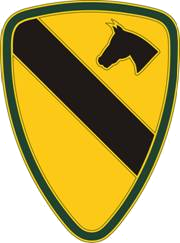
Heralds of Destruction: Heraldry on Miniatures
So that’s enough (oversimplified, poorly researched) history for one day. Let’s talk about how this applies to tiny plastic spacemen! Warhammer is already full of this stuff, with tons of artwork and studio paintjobs portraying designs on weapons, banners, tilting plates, shields, and armor. Any blank area is a suitable candidate for painting in some heraldry, while some models may have heraldic devices sculpted on. Heraldry is useful on the tabletop for three main reasons:
- Unit identification
- Adding character to your army
- Visual pizazz
Unit Identification
Ancient regents and warlords would identify their units at a distance with banners and shields, and you can do the same! At some point, everybody has had the issue where multiple units blend together on the tabletop. Maybe two mobs of Ork Boyz got too close to each other and you had to remember which mob took casualties and which one didn’t. Maybe your three squads of Guardsmen were supporting each other too closely and now one squad is twelve lasguns and two sergeants and the other has all your plasma guns in it. While Intercessor Squads I-IX are all using the same models in the same scheme, you can add some identifying heraldry to mark each squad out. For example I’ll show two of my squads of Intercessors, both built from Dark Imperium:

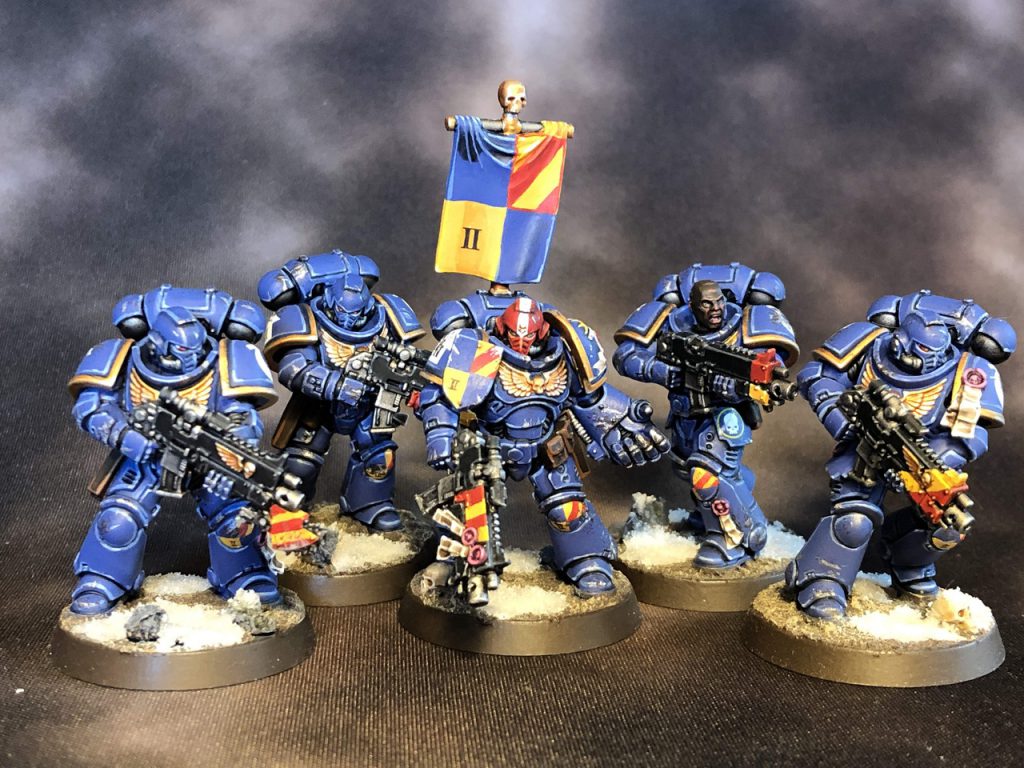
While largely the same models, by giving each squad its own heraldry I’ve made it easy to tell them apart on the battlefield. The repeating device on the left kneepad of each Marine is something I carry across the entire army, while using the heraldic colors on the weapons helps identify them at a glance and distinguish what would otherwise be samey poses. Adding banners helps as well, as it not only serves to identify the squads, but it gives some verticality to the units and helps them stand out.
Note how each squad’s heraldry has their own patterns as well as their own colors. Picking your colors is important, as you want to choose ones consistent with your scheme. Greens, teals, and purples would clash with the blue and gold of these Ultramarines, but by using colors already in use in the scheme, I was able to give the units some visual appeal while keeping them uniform with the rest of the army.
Adding Character to Your Army
Heraldry is a great way to hint at backstory or heritage for the units in your army. Historically, units would have banners identifying where they were from and who they were fighting for. Is your Astra Militarum army serving a feudal lord? Are your Freeguild troopers mercenaries, fighting only for coin and ale? Do your Marines come from a tribal culture that venerates a certain animal? This is your chance to flesh those ideas out without subjecting your opponents to your army’s 30,000 word fanfiction.
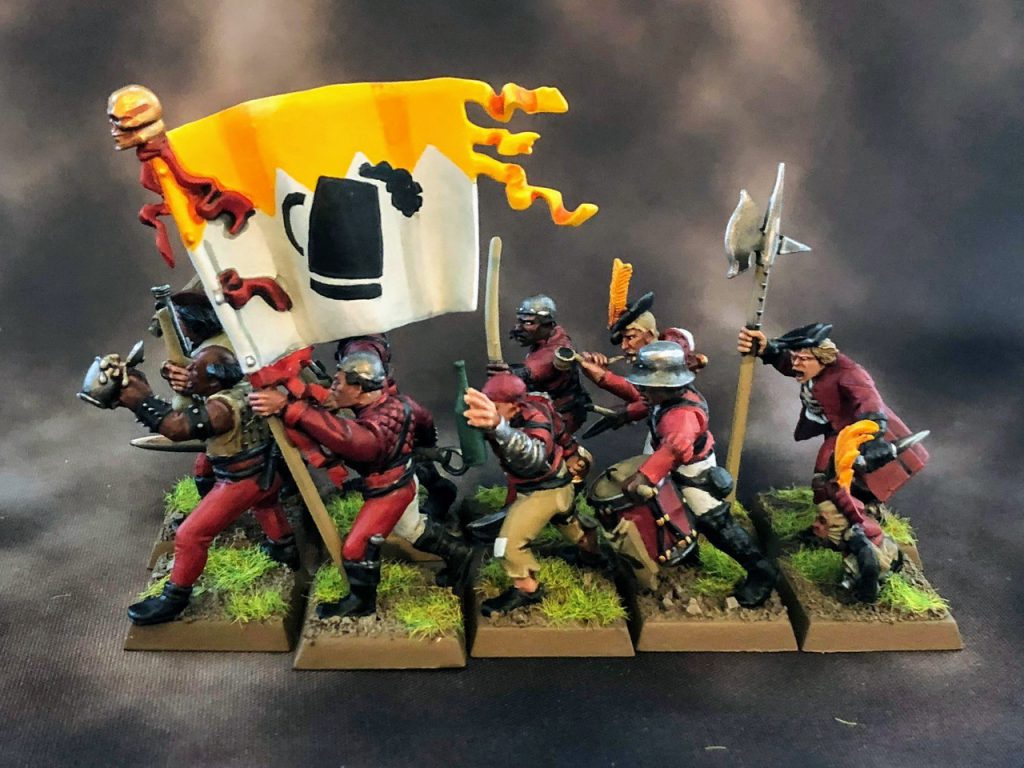
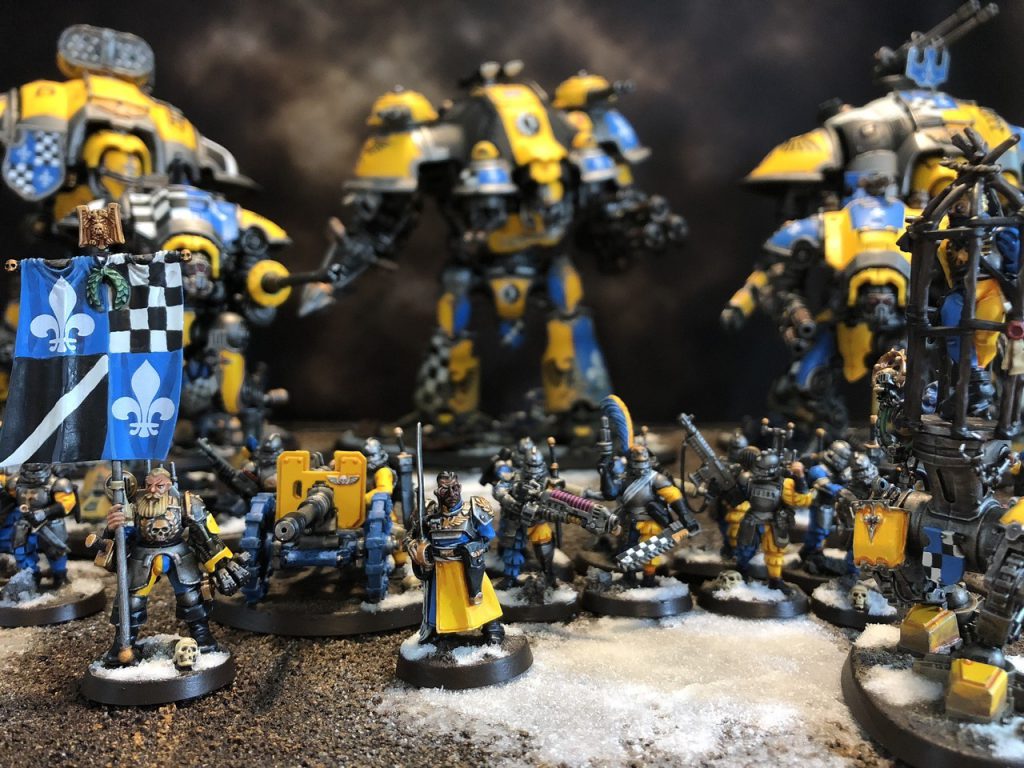
A picture’s worth a thousand words, and a design element here or there can say an awful lot about your army, even if you’re garbage at freehand like I am. Transfers are extremely good for this, as they do a lot of the work for you. For instance, in the House Lakar heraldry above, the fleur de lys transfers turn what would otherwise be plain blue fields into identifiable symbols of the army. In my mind, the fleur de lys symbolize the verdant agriculture of their world, the blue represents the clear blue skies, the yellow the wealth of the nobles, and the checkerboards represent the Knights themselves. By repeating these elements from the Knights down to the infantry, it themes the force and turns what would be a meta-chasing Loyal 32 into an organic part of the army.
Similarly useful for theming a force are campaign badges. Transfer sheets are full of these – axes, skulls, lightning bolts, and other badges you can use across a force to tie them together. This could be a badge indicating a certain crusade, campaign, or battle the army had fought together in the past repeated across the army. While especially thematic for forces like Black Templars, this is even more effective when a force consists of units from different armies. A unified Imperial army of Space Marines, Astra Militarum, and Adeptus Mechanicus, all sharing the same campaign badge across them would unify the force and tell a story, all through a simple piece of heraldry.
Visual Pizazz
Finally, and debatably most importantly, is the zazz factor. An army can be a sea of the same colors and patterns, and heraldry can break that up. It can even disguise what are otherwise fairly simple paintjobs by drawing the eye away from chunky highlights and sloppy brushwork towards banners and shields that proudly display your army’s glory. For example, my Empire army is on the whole pretty simple, with just a wash and a highlight on my line infantry. However, they carry banners that are far more attention grabbing than the wonky left eyeball on swordsman #27.
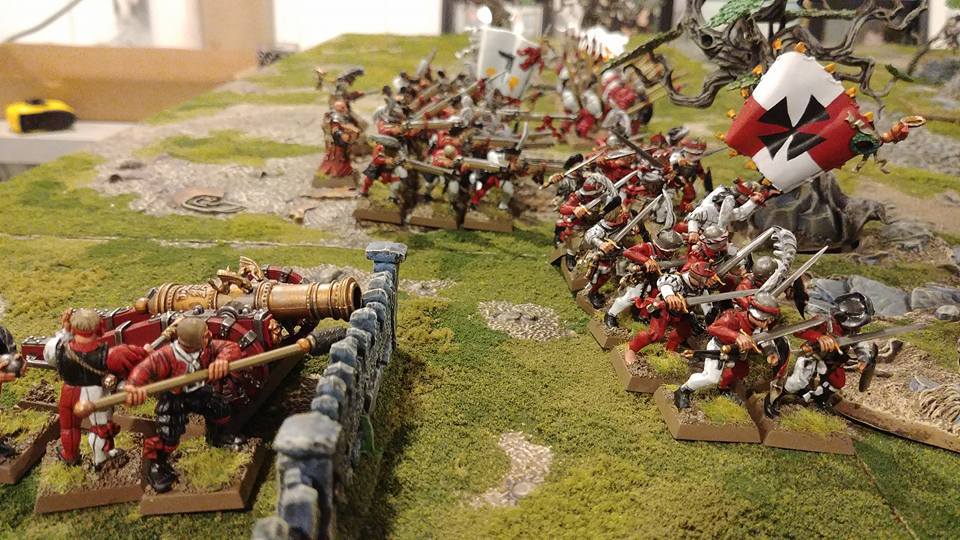
Alternatively, heraldry can be something you lavish attention on, using it to make a good paintjob a great one. Imperial Knights are tailor-made for this, and their large blank armor plates give the opportunity to highlight the individuality of each Knight.
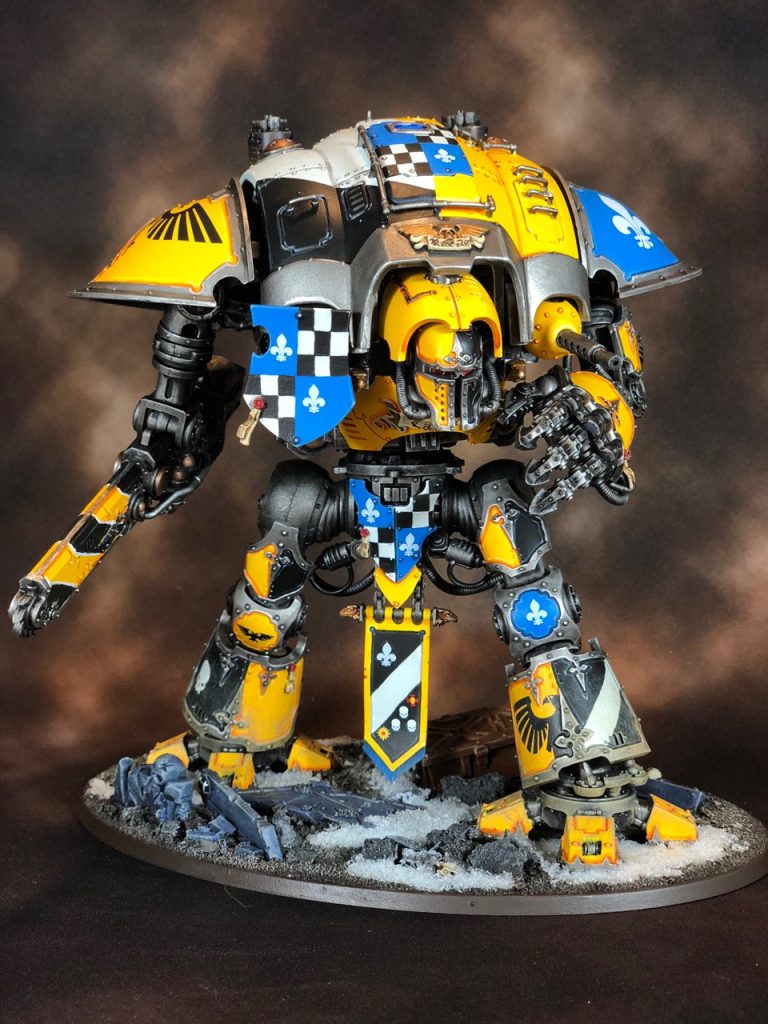
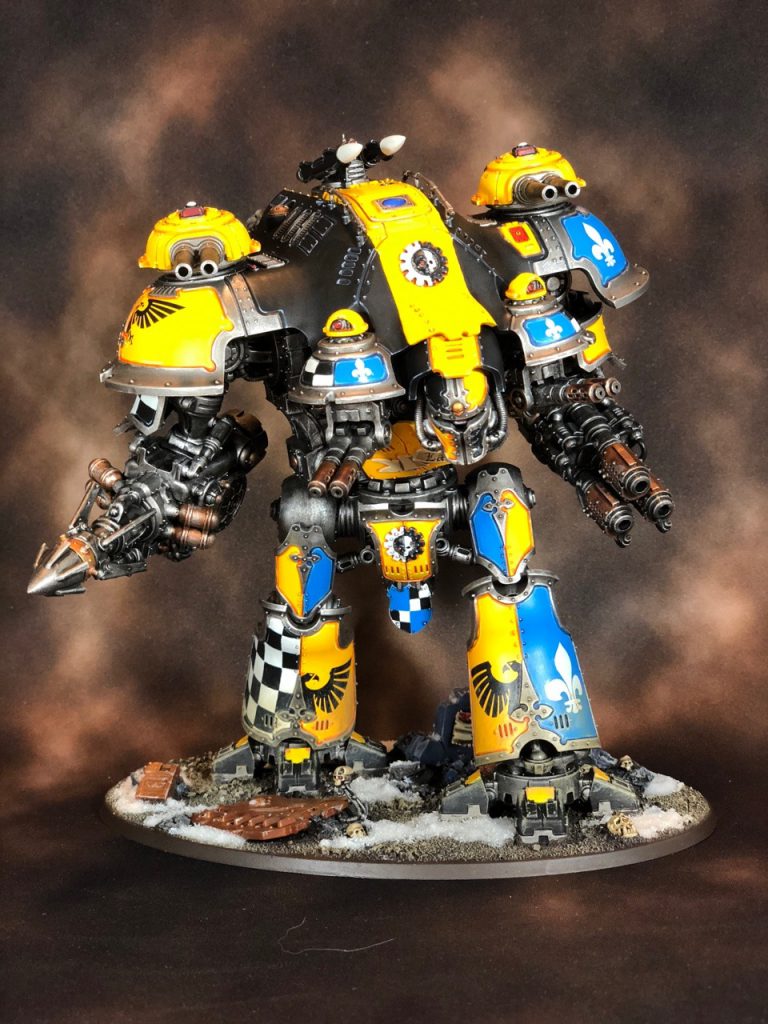
With creative use of heraldry, every unit can be unique and characterful, and every unit can tell a story. Different patterns can represent different ideas or aesthetics, and simple shapes and devices can go a long way.
Heralding our Departure: Further Reading and Inspiration
First and foremost, I would recommend Osprey Publishing’s Men at Arms series. These detail military uniforms with gorgeous illustrations and well-researched history, giving you designs you can draw from as well as information you can use to inspire your decisions. I used their Landsknechts book while painting my Empire army, and my dad even wrote one of their books on the Irish brigades of France and Spain!
Next, if you can find them, are Games Workshop’s own books on heraldry and uniforms. Although long out of print, there were three books in the Uniforms and Heraldry series for Warhammer Fantasy: Uniforms and Heraldry of the Empire, Uniforms and Heraldry of the Skaven, and Uniforms and Heraldry of the High Elves. Think of them like fantasy Osprey books, with illustrations and color plates abound. There have also been a few for 40k, namely Insignium Astartes, which details the markings of codex Space Marine chapters, and the Imperial Knight Companion book that accompanied an earlier Imperial Knights release. Any given codex or Imperial Armour book will have plenty of this stuff in there as well, with Forgeworld’s books really going the extra mile to display variations on schemes and individual heraldry.
Finally, if you have access to a history museum, go check it out! Whether it’s colonial battleflags, medieval Norman shields, Edo period Samurai armor, or modern military insignia, there’s inspiration around every corner. While war is nasty, miserable business, the artistry involved in its tools can be beautiful and serve as inspiration for your own works. Real world history serves as the inspiration for nearly everything in Warhammer, and immersing yourself in it will only serve to better your hobby and understanding of the world at large.


